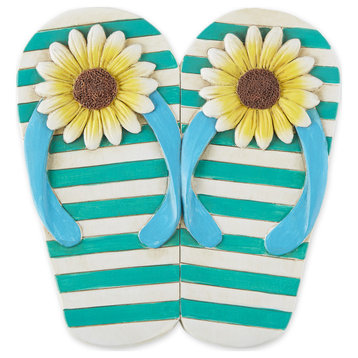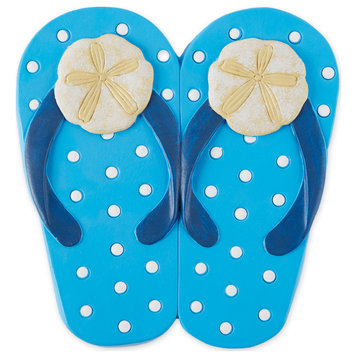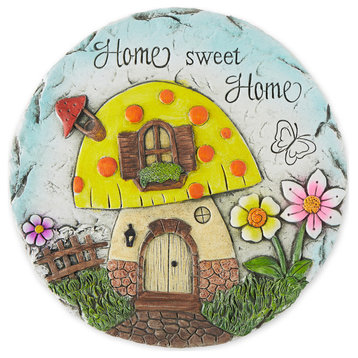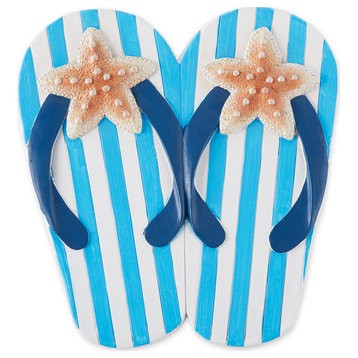FREE shipping on orders over $49!* Details
Landscaping Stones and Pavers
5 Results
Sort by:
Price
5 Results

Sunflower Stripe Flip Flop Stepping Stoneby EL: STORAGE
$63
Free Shipping
SUNFLOWER STRIPE FLIP FLOP STEPPING STONEDII offers full collections of trend based designs, bringing you fresh, innovative lines of quality home and garden products for every season. Let DII products become a valuable part of your life.
- MEASUREMENTS: The stepping stone weighs 3.3 lbs and measures 9x9.5 in diameter and 1" thick
- DURABLE AND LONG-LASTING: Made of cement to create a durable and decorative garden pathway
- EASY CARE: Stepping stones are weather resistant and easy to care for; To clean your stepping stone wash with a soft damp cloth.
- ENHANCE YOUR OUTDOOR SPACE: Bring the beach to your garden space with these sweet colorful flip flop sandal stepping stones

Sand Dollar Flip Flops Stepping Stoneby EL: STORAGE
$64
Free Shipping
SAND DOLLAR FLIP FLOPS STEPPING STONEDII offers full collections of trend based designs, bringing you fresh, innovative lines of quality home and garden products for every season. Let DII products become a valuable part of your life.
- MEASUREMENTS: The stepping stone weighs 3.3 lbs and measures 9x9.5 in diameter and 1" thick
- DURABLE AND LONG-LASTING: Made of cement to create a durable and decorative garden pathway
- EASY CARE: Stepping stones are weather resistant and easy to care for. To clean your stepping stone wash with a soft damp cloth.
- ENHANCE YOUR OUTDOOR SPACE: Bring the beach to your garden space with these sweet colorful flip flop sandal stepping stones.

Home Sweet Home Stepping Stoneby EL: STORAGE
$62
Free Shipping
HOME SWEET HOME STEPPING STONEDII offers full collections of trend based designs, bringing you fresh, innovative lines of quality home and garden products for every season. Let DII products become a valuable part of your life.
- MEASUREMENTS: The stepping stone weighs 3.3 lbs and measures 9.75 in diameter and 1" thick
- DURABLE AND LONG-LASTING: Made of cement to create a durable and decorative garden pathway.
- EASY CARE: Stepping stones are weather resistant and easy to care for; To clean your stepping stone wash with a soft damp cloth
- ENHANCE YOUR OUTDOOR SPACE: Garden stepping stones can be placed along a grass or gravel path or placed among your garden beds

Starfish Flip Flops Stepping Stoneby EL: STORAGE
$62
Free Shipping
STARFISH FLIP FLOPS STEPPING STONEDII offers full collections of trend based designs, bringing you fresh, innovative lines of quality home and garden products for every season. Let DII products become a valuable part of your life.
- MEASUREMENTS: The stepping stone weighs 3.3 lbs and measures 9x9.5 in diameter and 1" thick
- DURABLE AND LONG-LASTING: Made of cement to create a durable and decorative garden pathway
- EASY CARE: Stepping stones are weather resistant and easy to care for. To clean your stepping stone wash with a soft damp cloth.
- ENHANCE YOUR OUTDOOR SPACE: Bring the beach to your garden space with these sweet colorful flip flop sandal stepping stones.

In Life I Loved You Dearly, In Death I Love You Still Memorial Stepping Stoneby EL: STORAGE
$64
Free Shipping
IN LIFE I LOVED YOU DEARLY, IN DEATH I LOVE YOU STILL MEMORIAL STEPPING STONEDII offers full collections of trend based designs, bringing you fresh, innovative lines of quality home and garden products for every season. Let DII products become a valuable part of your life.
- MEASUREMENTS: Cement stepping stone weighs 3.3 pounds and measures 9.75 inches in diameter and is 1" thick
- DURABLE AND LONG-LASTING: Made of cement to create a durable and decorative garden pathway
- EASY CARE: To clean your stepping stone, wipe with a soft damp cloth
- ENHANCE YOUR OUTDOOR SPACE: Turn your garden into a place of remembrance with this warm and inviting welcome stepping stone
Beautifying your outdoor landscape is a careful balance between soft greenery and the hard lines of pavers, retaining walls and landscaping rocks. While these may not initially jump out at you as ideal choices when you begin planning your landscaping, their strong contrast, texture and functionality shouldn’t be overlooked. Of course, landscaping takes a good amount of planning, so it’s best to educate yourself on the choices you have available before you outline your final plan. Read on for some tips and information on how you can add landscaping stones, pavers and retaining walls to your landscape.
If the main purpose behind your retaining wall is functional, you’ll most likely want one that’s professionally built with reinforcement components. However, if your retaining wall is meant to simply provide aesthetic appeal, you can choose more decorative components and even build one yourself using retaining wall blocks and other materials. Either way, your choice of materials includes:
• Wood and timber: Easy to install and long lasting if treated properly, these are the most common materials used in retaining walls.
• Concrete: Available in a wide range of styles, concrete blocks are low in cost, easy to install and surprisingly lightweight. You can choose between interlocking, hollow, solid and half hollow styles, all of which are highly customizable.
• Natural stone blocks: Though they’re typically the most expensive choice, natural stone blocks have a unique look all their own. You can find them in blocks, units, irregular and regular shapes.
• Stone blocks: Though they’re manmade, stone blocks are crafted to resemble real stone. They’re also fairly affordable.
• Brick: Pest, weather and fire-resistant, brick retaining walls are versatile and durable enough to stand the test of time. They also don’t rot or corrode and have a timeless appeal.
For more ideas of how a rock retaining wall can add style and functionality to your yard, check out our article “10 Rock Wall Ideas for a Style-Strong Patio”.
Pavers can create long, winding pathways or decorative patios that simply beckon you outdoors. These relatively inexpensive stones can transform your outdoor area thanks to their wide variety of decorative yet durable materials, shapes and colors. Materials include:
• Natural stone: With a beautiful range of natural colors and textures, natural stone is available in dozens of styles. Flagstone and fieldstone remain the most common, however. These two styles work best as stepping stones leading to a garden or through your lush landscape. Flagstone can also be used to build a patio.
• Limestone: Another type of natural stone, limestone pavers are best used as decorative edging. Use it to separate a garden plot from your yard or to fence off landscaping from the lawn. Limestone’s durability means it will hold up against your weed trimmer and lawn mower, not to mention harsh weather conditions.
• Brick: Genuine brick, which is made with clay and shale, provides extreme durability and rich, long-lasting color. You can also opt for cheaper brick that’s manufactured from concrete and aggregate. This cheaper alternative is dyed, however, so you can expect the color to fade over time.
• Precast concrete: Made from cement and aggregate, concrete pavers can be dyed to the color of your choice. This style is molded into various shapes, including interlocking designs that increase the ease of installation.
Want more ideas for creating a gorgeous patio or pathway with pavers? Take a peek at our article “Patio Pavers Rock Out”.
Depending on how you wish to use them, landscaping stones can vary in size from large boulders to gravel-sized river rocks. You can use smaller styles to replace mulch and create a weed barrier around plants, shrubs and trees — even those housed in containers. Larger boulders can be used to add height, texture and contrast in your flower garden. Try layering flowers around your landscaping stones. If you find a boulder that simply calls to you with its unique shape, colors or textures, make it the centerpiece.
Discover even more ideas for adding landscaping rocks to your garden or yard by reading our article “Easy-care Landscaping with Rocks and Boulders”.
What kind of retaining wall is best?
If the main purpose behind your retaining wall is functional, you’ll most likely want one that’s professionally built with reinforcement components. However, if your retaining wall is meant to simply provide aesthetic appeal, you can choose more decorative components and even build one yourself using retaining wall blocks and other materials. Either way, your choice of materials includes:
• Wood and timber: Easy to install and long lasting if treated properly, these are the most common materials used in retaining walls.
• Concrete: Available in a wide range of styles, concrete blocks are low in cost, easy to install and surprisingly lightweight. You can choose between interlocking, hollow, solid and half hollow styles, all of which are highly customizable.
• Natural stone blocks: Though they’re typically the most expensive choice, natural stone blocks have a unique look all their own. You can find them in blocks, units, irregular and regular shapes.
• Stone blocks: Though they’re manmade, stone blocks are crafted to resemble real stone. They’re also fairly affordable.
• Brick: Pest, weather and fire-resistant, brick retaining walls are versatile and durable enough to stand the test of time. They also don’t rot or corrode and have a timeless appeal.
For more ideas of how a rock retaining wall can add style and functionality to your yard, check out our article “10 Rock Wall Ideas for a Style-Strong Patio”.
What kinds of pavers should I choose?
Pavers can create long, winding pathways or decorative patios that simply beckon you outdoors. These relatively inexpensive stones can transform your outdoor area thanks to their wide variety of decorative yet durable materials, shapes and colors. Materials include:
• Natural stone: With a beautiful range of natural colors and textures, natural stone is available in dozens of styles. Flagstone and fieldstone remain the most common, however. These two styles work best as stepping stones leading to a garden or through your lush landscape. Flagstone can also be used to build a patio.
• Limestone: Another type of natural stone, limestone pavers are best used as decorative edging. Use it to separate a garden plot from your yard or to fence off landscaping from the lawn. Limestone’s durability means it will hold up against your weed trimmer and lawn mower, not to mention harsh weather conditions.
• Brick: Genuine brick, which is made with clay and shale, provides extreme durability and rich, long-lasting color. You can also opt for cheaper brick that’s manufactured from concrete and aggregate. This cheaper alternative is dyed, however, so you can expect the color to fade over time.
• Precast concrete: Made from cement and aggregate, concrete pavers can be dyed to the color of your choice. This style is molded into various shapes, including interlocking designs that increase the ease of installation.
Want more ideas for creating a gorgeous patio or pathway with pavers? Take a peek at our article “Patio Pavers Rock Out”.
How can I use landscaping rocks in my yard?
Depending on how you wish to use them, landscaping stones can vary in size from large boulders to gravel-sized river rocks. You can use smaller styles to replace mulch and create a weed barrier around plants, shrubs and trees — even those housed in containers. Larger boulders can be used to add height, texture and contrast in your flower garden. Try layering flowers around your landscaping stones. If you find a boulder that simply calls to you with its unique shape, colors or textures, make it the centerpiece.
Discover even more ideas for adding landscaping rocks to your garden or yard by reading our article “Easy-care Landscaping with Rocks and Boulders”.






